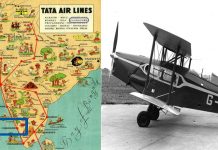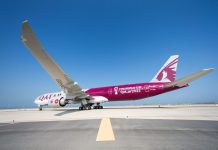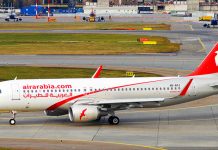20 Codes Pilots Use In The Air That No One Else Understands
20. DEPLANE
The term deplane simply refers to the opposite of boarding your assigned aircraft. That means, it refers to passengers getting off the plane. According to the website Ask the Pilot, deplane is a term that dates back to the 1920s. However, there were those who did not feel comfortable about utilizing the word plane as a verb. This was reportedly because the practice might be applied to other nouns, such as a car (decar) or boat (deboat).
 Today, this term is still being utilized by various airlines around the world. However, flight attendants and pilots have also been known to use another word in its place. That is none other than “disembark.”
Today, this term is still being utilized by various airlines around the world. However, flight attendants and pilots have also been known to use another word in its place. That is none other than “disembark.”
19. AIR POCKET
At some point during one of your flights, you might have heard the pilot’s voice come on as he or she apologizes for the air pockets, which could result in a rather turbulent flying experience. According to Ask the Pilot, an air pocket simply refers to “a transient jolt of turbulence.”

This occurs when air rises vertically at higher altitudes. Meanwhile, turbulence can also be caused by mountains in the area. “If there’s a strong wind, the air may be steered upward when it encounters higher mountains,” the airline further explained.
18. CODE ADAM
According to a report from The Sun, Code Adam is a code that is used by the airport staff to alert others of a missing child. The code is reportedly in honor of a child named Adam Walsh who was abducted from a department store back in 1981.

If you are traveling with a child on a plane, it is always a good idea to find ways to keep them occupied so that they would not be encouraged to get off their seats and try to run around the plane. For this, you can utilize the plane’s onboard entertainment services where kids can watch cartoons or even play some interactive games. On the other hand, you can also bring some coloring books, puzzles or small board games that can make the flight a lot more fun for your child.
17. V1
Perhaps, V1 is a code that you have not heard before. This is because this is a term that is not intended to be heard by commercial airline passengers. That is unless someone in the flight crew had accidentally left the intercom on.

According to a report from Traveller, V1 refers to a point wherein the aircraft has already reached a speed that it is too fast to abort takeoff with the remaining available part of the runway.
However, V1 is also a point wherein the aircraft is not yet fast enough for takeoff. Typically, the pilot who is not currently flying the aircraft will be the one to call V1 as the plane goes through its takeoff roll.
16. 7500
7500 is the one code that no one would ever want to hear. This is because 7500 is a code that a pilot would only use if the flight has already been hijacked or if it is currently facing a possible hijacking threat.

The good news for air travelers today is that commercial plane hijackings have been quite rare recently. In fact, according to a report from Express, it has been found that there is only one commercial flight accident per 4.5 million flights. At the same time, both commercial airlines and airports have also become more vigilant recently in ensuring passenger security in the airport and in the air. Hence, there is really nothing to worry about.
15. EQUIPMENT
Believe it or not, equipment simply refers to the plane itself. It is not sure why pilots refer to it this way, but this practice has persisted for years. Have you ever been told that your flight would be delayed due to an equipment change?

This means that the airplane for your flight was possibly changed at the last minute due to a critical concern.
Although as “Cockpit Confidential” author Patrick Smith has remarked,” Is there not something strange about the refusal to call the focal object of the entire industry by its real name?” Well, we’ll have to agree with him on this.
14. DOORS TO ARRIVAL AND CROSS CHECK
Doors to arrival is an instruction that you tend to hear from a pilot once a plane is landing. This is always issued to flight attendants. The reason for this instruction is to make sure that the emergency escape slides that are attached to the plane’s doors have already been disarmed prior to landing. If this was not done, there is a good chance that the slides would suddenly deploy the moment the cabin crew opens the doors at the gate.

On the other hand, cross check is an instruction that is issued to let a flight attendant know that they should double check each other’s work with regard to the disarming of the doors. In the cabin, flight attendants would typically do a cross check on another attendant’s station.
13. ALL-CALL
All-call is an instruction often issued along with the previous codes. Hence, you would typically hear the words, “Flight attendants, doors to arrival, cross check and all-call.”
Just like doors to arrival and cross check, the all-call code also has something to do with the arming and disarming procedure of the plane’s doors.

You see, while the plane is in the air, the doors are essentially armed with the emergency escape slides. This allows the flight crew to evacuate the plane in a quicker and more efficient manner in case of a major emergency or crash landing.
And when the plane is touching down, the doors have to be disarmed to prevent accidents when the plane is preparing to disembark passengers. In this case, all-call refers to a request for each flight attendant to report from his or her own station using the plane’s intercom.
12. DIRECT FLIGHT
Technically speaking, a direct flight refers to a situation wherein the routing and flight number of a commercial airplane is not changed. Whether the plane would have to make a stop is not a factor here.

Typically, passengers make the mistake of immediately assuming that an airplane would fly nonstop to a destination because it is a direct flight. To find out if it really is, it is highly recommended to refer to the fine print on your booking. You can also verify this information with any of the flight attendants. On the other hand, if you want a nonstop flight, it is also best to confirm the route and schedule of a flight before you purchase your airline tickets.
11. FLIGHT LEVEL
Flight level simply refers to the altitude your plane is flying on. As international airline pilot Dan Boland has remarked to Reader’s Digest, “The words ‘flight level’ are an abbreviated way to say altitude. So, if you hear ‘flight level 350,’ that means 35,000 feet.”

According to a report from USA Today, commercial jet airplanes typically fly at a cruising altitude of around 35,000 feet, although this number generally varies from 33,000 to 42,000 feet.
On the other end, private jets typically take just a slightly higher cruising altitude of around 41,000 feet. This allows them to stay above most of the commercial air traffic.
10. AREA OF WEATHER
When a pilot uses the code area of weather, he or she is typically referring to an area that is currently experiencing thunderstorms. On the other hand, the pilot may also be referring to a certain zone that is currently experiencing heavy precipitation.

In cases like this, the pilot may decide to divert the route of the flight for a safer and less turbulent experience for passengers. If this is the case, he or she might use the plane communications to relay to the passengers that the plane is turning somewhere to avoid experiencing turbulence. On the other hand, the “Fasten Your Seatbelt” sign in the cabin might also be illuminated around this time.
9. HOLDING PATTERN
According to Ask the Pilot, a holding pattern simply refers to “a racetrack-shaped course flown during weather or traffic delays.” Traffic delays can be the result of an overcrowded runway with lots of other commercial planes landing and/or preparing to take off.
As a result, there may not be any readily available gate or mobile stairway that your flight can use when the passengers deplane. Because of this, a flight can be asked to maintain a holding pattern until a gate or a runway becomes available.

On the other hand, a commercial plane may also be asked to maintain a holding pattern in the air if there was an incident involving another plane on the tarmac or runway. In which case, the plane would have to remain in the air until the scene has been cleared or until the flight can be diverted to another runway.
8. GROUND STOP
Of all the code words that pilots use, ground stop is one the one term that you would not want to hear. According to a report from Business Insider, this code refers to “the point when departures to one or more destinations are curtailed by air traffic control; usually due to a traffic backlog.” Used in a sentence, a pilot might say, “Sorry folks, but there’s a ground stop on all flights headed south from here.”

With so many passengers traveling to various destinations throughout the U.S. daily, it is no wonder that ground stops unfortunately occur. The best way to avoid these is to fly out from less crowded airports. According to a report on the busiest U.S. airports by Airports Council International, the ones to avoid are Atlanta, Los Angeles, Chicago O’Hare, Dallas Forth Worth and New York JFK.
7. EFC TIME
EFC time refers to the expect further clearance time. Sometimes known as the release time, it is a point at which a flight crew is expecting to finally be set free from the holding pattern the commercial flight has been on.
On the other hand, the EFC time can also refer to a point in which the flight crew is expected to be exempted from the ground stop.

One way that the pilot may use the code EFC time is by including it in an announcement such as, “We have been given an EFC time of 20 minutes after the hour.”
6. WHEELS-UP TIME
In contrast to EFC time, the code wheels-up time refers to a point when a plane that is still stopped at the ground expects to become fully airborne. Hence, the pilot and his or her flight crew must work together to ensure that the plane is already at or very near the runway before the stated wheels-up time for the flight.

Aside from being able to board all the passengers quickly, that would also mean being able to load the passengers’ luggage in a timely and efficient manner. Meanwhile, final maintenance checks of the flight and delivery of other essentials such as the inflight meals also have to be done well before the stated wheels-up time for the flight.
5. FINAL APPROACH
Often times, as a commercial airplane’s flight time nears its end, you would often hear the pilot’s voice as he or she announces the plane is now on its final approach. Typically, it would sound like, “Ladies and gentlemen, we are no on our final approach into Atlanta.”

For any commercial pilot, an airplane is defined to be on its final approach the moment it has already reached its last straight-in segment of the flight’s landing pattern.
At this point, the plane is also already aligned with the extended centerline of the airport’s runway. Hence, there would be no more additional maneuvering or turns required for the plane before it lands.
4. LAST MINUTE PAPERWORK
At some point on one of your flights, you have probably already encountered this scenario. There you are, settled comfortably in your seat with your seatbelt fastened. You are aware the cabin crew has already closed the plane doors, so you should be taking off soon enough.

But just when you think that things are moving along nicely, the pilot’s voice suddenly comes on. He or she might say, “We are just finishing some last minute paperwork and we should be underway shortly.” Last minute paperwork is typically code for the need to check or recheck the weight and balance record of the plane. On the other hand, it can also have something to do with a revision in the plane’s flight plan.
3. GEORGE
Should you ever hear a pilot say the name George, you should not immediately assume that he or she is referring to a person. According to a report from Traveller, George typically refers to autopilot.

Typically, autopilot refers to a technology that the pilot engages during the duration of the flight. As AeroTech Research president and CEO Paul Robinson has explained to CNBC, “Basically it is a computer that is running very, very fast. It can almost fly the plane completely between takeoff and landing.” As you can see, this is very much similar to the autopilot feature that is available in today’s cars.
Before taking off, a pilot would enter the route into the computer so that it would have the start and end position as well as the exact way to get there. The autopilot will then use this information while it also relies on sensors throughout the aircraft that indicate altitude, speed, and turbulence.
2. OCT
OCT simply stands for onwards clearance time. As Boland explained, “The context would be a delay while in a holding pattern or on the ground while waiting to push back from the gate.” On the other hand, he also added, “ATC (air traffic control) has provided the pilots with an accurate time to continue on to the destination with no further delays expected.”

You might experience delays as a result of too many commercial planes scheduled to land or take off around the same time.
Just remember, when you hear the code OCT over the plane communications, there is absolutely nothing to worry about.
1. DEADHEAD
In the airline industry, a deadhead can refer to a pilot or flight attendant. According to the website Ask the Pilot, a deadheading flight crew employee is someone who is “repositioning as part of an on-duty assignment. Meanwhile, the site further clarified, “This is not the same as commuting to work or engaging in personal travel.”

A change in pilot or flight crew may be needed if the personnel in question has already reached the maximum allowed hours of continuous duty.
According to a report from Chron, the Federal Aviation Administration has imposed a maximum of 60 flying hours for pilots each week. And during any consecutive 28-day period, a pilot is also not allowed to exceed 290 hours.
Sources: faa.gov, bts.gov, aci-na.org, askthepilot.com, usatoday.com



















